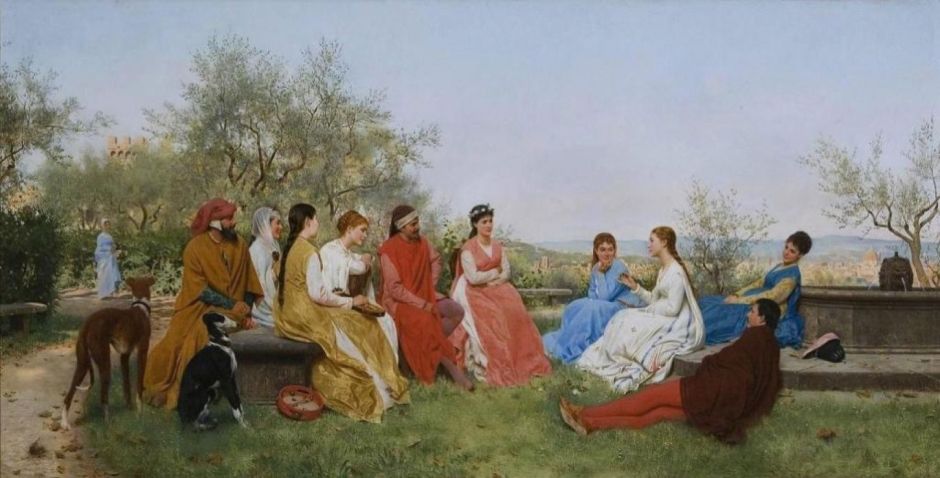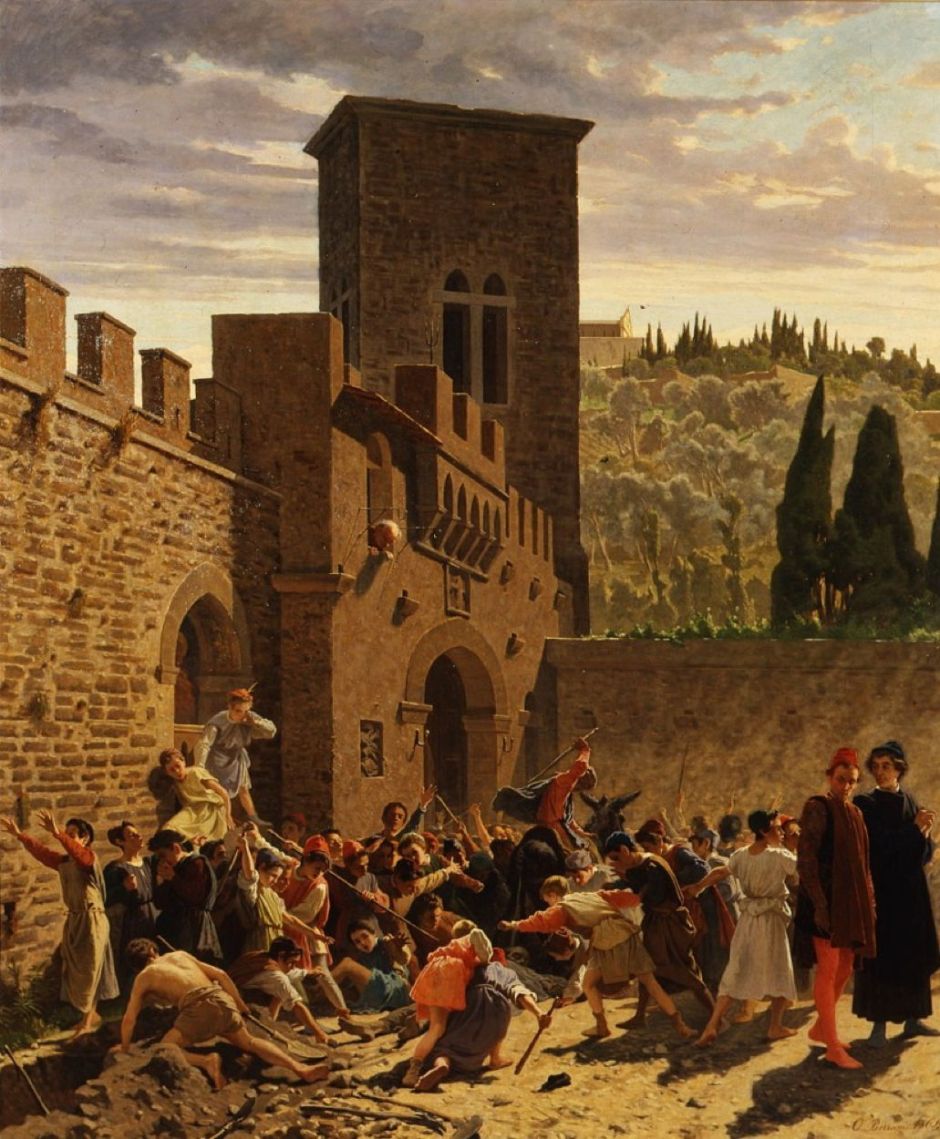The city of Florence, to the north-west of Rome, in Tuscany, has long been a centre of art. Even before the Renaissance, its painters were among the most prominent in southern Europe, and it’s often referred to as being the cradle of the Renaissance, or the Athens of Italy. Thereafter its unique collections of Renaissance art have attracted artists from all over the world, and encouraged them to paint views of the city. This article and tomorrow’s sequel look at a small selection of paintings of Florence: this concentrates on historical recreations, and tomorrow’s on contemporary landscapes.
Dante and his Divine Comedy have inspired and influenced a great many paintings, some of which have attempted to show the poet in the city of his birth.

The year after Dante Gabriel Rossetti’s death in 1882, Henry Holiday painted the second occasion on which Dante claimed he had met with his beloved Beatrice, in Dante meets Beatrice at Ponte Santa Trinita (1883). Holiday devoted great effort to making this view of the Ponte Vecchio and River Arno in central Florence as authentic as possible. In 1881, he travelled to Florence to make studies, and researched the buildings at the time, which he turned into clay models for a 3D reference. He also got John Trivett Nettleship, a noted animal painter, to paint the pigeons so that they too were faithfully depicted.

Rossetti’s more fictionalised watercolour of The First Anniversary of the Death of Beatrice (1853) shows Dante being comforted as he is drawing an angel on that day of remembrance for his beloved. This is situated in central Florence according to the view through the window at the right, but looking out of the door at the left, there’s an incongruous country garden.
Dante himself died in 1321, and the next major event in the history of Florence is linked with Boccaccio’s Decameron, which was written by 1353.

Doubt has been cast that Boccaccio’s description of the Black Death which struck Florence in 1348 was based on his personal experience, but few alive at the time could have escaped witnessing its deadly consequences. Much later, in the early nineteenth century, Luigi Sabatelli made this engraving to illustrate an edition of the Decameron, in his undated Plague of Florence in 1348.
The Decameron opens with a description of the horrific conditions and events which overwhelmed Florence when the Black Death struck, then takes us to a group of seven young women who are taking shelter in one of its great churches. They decide to leave the city, rather than waiting amidst its rising pile of corpses, to spend some time in the country nearby. To accompany them, they take a few servants, and three young men.
Once settled in an abandoned mansion, the ten decide that one of the means by which they will pass their self-imposed exile is by telling one another stories. Over the next two weeks, each tells one story on every weekday, providing the total of one hundred which form The Decameron.

Raffaello Sorbi shows the group of ten during one of the story-telling sessions in The Decameron from 1876, with Florence in the distance.
A notable absence from the skyline of those paintings of the city before 1420 is the distinctive brick dome designed by Filippo Brunelleschi (1377-1446) which crowns Florence Cathedral, the Duomo, or more properly the Cattedrale di Santa Maria del Fiore. Sorbi’s backdrop is anachronistic in that it shows the dome.
Brunelleschi was a central figure in the Southern Renaissance, an architect and civil engineer who is generally credited with developing the first geometrically correct perspective projection for use in 2D drawings and paintings. It was he who both designed and supervised the construction of this prominent landmark, and he died in the city on 15 April 1446.

His death and achievements are commemorated by Frederic, Lord Leighton, who follows convention in locating the event in a building in Florence, the window opening to a view of the cathedral’s dome. Brunelleschi is shown half-recumbent in extremis in a chair, as if flattened onto a two dimensional plane. The complex array of buildings seen between the window and the dome appear to defy correct perspective projection, but have in fact been carefully projected, and contrast with the flatness of the dying man.

Leighton had earlier painted Cimabue’s Celebrated Madonna is Carried in Procession through the Streets of Florence (1853-55). Cimabue (c 1240-1302) was born and probably trained in Florence, and is claimed to have been the teacher of Giotto – both key figures in the development of the early Renaissance.

Inside the Duomo is Domenico di Michelino’s fresco of Dante and the Divine Comedy, the poet’s 1465 memorial. It shows Dante holding a copy of The Divine Comedy as he points out sinners descending to Hell. Behind him is the mountain of Purgatory, at the top of which is Paradise. To the right is the city of Florence, complete with the dome whose construction wasn’t started until a century after Dante’s death.
Among the many major artists of the Florentine Renaissance is Alessandro di Mariano di Vanni Filipepi, better-known as Sandro Botticelli, who was born in the city in about 1445 and spent almost his entire life in the same part of town, leaving it for just two brief periods when he painted in Pisa and Rome.

Eleanor Fortescue-Brickdale’s Botticelli’s studio: The first visit of Simonetta presented by Giulio and Lorenzo de Medici (1922) imagines an event which could only have taken place before Easter in 1478, when Botticelli could have been no older than 33. The artist stands at the left, in front of an exquisite tondo which he is working on. Bowing to him at the centre is Giuliano de’ Medici, who is accompanied by Simonetta Vespucci, wearing the green dress. Behind her is Lorenzo de’ Medici, often known as Lorenzo the Magnificent, and behind him are Giovanna Tornabuoni and her attendants. The view through the window shows the Palazzo Vecchio in the centre of Florence.

Lorenzo de’ Medici is the subject of Girolamo Macchietti’s undated portrait of Lorenzo the Magnificent. Lorenzo was born in 1449 into the banking family, the grandson of Cosimo de’ Medici, one of the wealthiest and most powerful people in Europe. Lorenzo was groomed for power, and became the de facto ruler of the Florentine Republic when his father died in 1469.
He survived a vicious attack by members of the Pazzi family, in the Duomo on Easter Sunday 1478, in which his brother Giuliano was stabbed to death. This led to his excommunication, and invasion by forces of the King of Naples. He resolved that, and died in 1492, when he was forty-three.

Odoardo Borrani was a nineteenth century Florentine painter whose painting of The Body of Jacopo de’ Pazzi from 1864 shows the more grisly side of Florence in 1478. Jacopo de’ Pazzi was the head of the noble banking family of the Pazzi who led that conspiracy against the ruling de’ Medici family, by attempting to assassinate Lorenzo and Giuliano de’ Medici and overthrow the government.
De’ Pazzi escaped from the city, but was hunted down, brought back, tortured and hung beside the corpse of another conspirator. His body was initially interred in the family chapel of Santa Croce, but it was then exhumed to be thrown in a ditch, as shown here. Eventually his head was used as a door knocker, and the rest of his family sent into exile.

The Florentine painter Fabio Borbottoni (1820–1902) spent much of his career creating historical landscapes showing the city in Renaissance times. This undated view of the Ponte alle Grazie and the Loggia of the Uffizi is among the large collection of his work now in the Cassa di Risparmio di Firenze.

